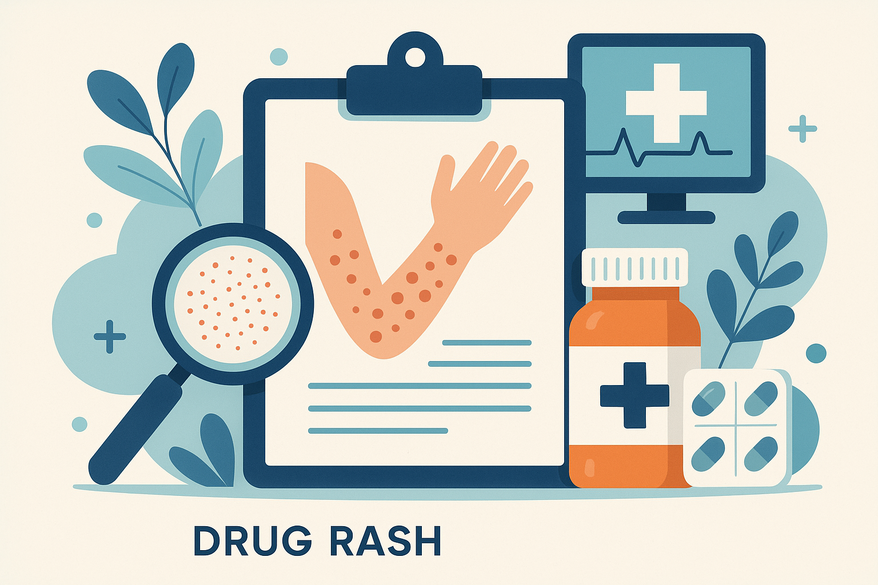Comprehensive Guide to Medication Rash Treatment
Discover effective medication rash treatment strategies for safe drug use, including identification, diagnosis, and management of adverse skin reactions.

Estimated reading time: 8 minutes
Key Takeaways
- Early recognition of medication-induced rashes can prevent serious complications.
- Prompt discontinuation of the offending drug is the first step in management.
- Over-the-counter antihistamines and topical steroids often relieve mild reactions.
- Severe cases may require systemic corticosteroids or immunosuppressants.
- Maintain a detailed medication history to prevent future drug eruptions.
Table of Contents
- Understanding Medication-Induced Rashes
- Identifying Symptoms of a Medication-Induced Rash
- Diagnosis and Professional Evaluation
- Medication Rash Treatment Options
- Managing and Preventing Future Rashes
- Practical Tips and Takeaways
- FAQ
Understanding Medication-Induced Rashes
A medication-induced rash is an adverse skin reaction caused by the body’s immune response or chemical irritation from drug intake. Recognizing these reactions underlies effective treatment. For more on recognizing these reactions, see Identifying and Managing Drug-Induced Rash Symptoms (source: DermNet NZ).
- Common Drug Classes That Trigger Rashes
- Antibiotics (e.g., penicillins, sulfonamides)
- Anti-seizure medications (e.g., lamotrigine, carbamazepine)
- NSAIDs (e.g., ibuprofen, naproxen)
- Certain heart drugs (e.g., amiodarone)
- Physiological Processes Behind Rashes
- Immediate hypersensitivity
– Onset within minutes to hours.
– Urticaria (hives) via histamine release from mast cells. - Delayed hypersensitivity
– Occurs days after drug start.
– Maculopapular eruptions, fixed drug eruptions, contact dermatitis. - Severe immune-mediated reactions
– Stevens-Johnson syndrome (SJS) and toxic epidermal necrolysis (TEN).
– Characterized by widespread necrosis of epidermis and mucous membranes.
- Immediate hypersensitivity
(source: Harvard Health Blog)
Identifying Symptoms of a Medication-Induced Rash
Early symptom recognition is crucial for prompt treatment. For a quick preliminary analysis, consider uploading rash photos to Rash Detector for an instant AI-generated report:

- Typical Symptoms
- Raised red bumps or hive-like welts across the body
- Pink or red macules spreading from torso to limbs
- Itching or peeling resembling sunburn
- In severe cases:
- Blistering and full-thickness skin necrosis
- Mucous membrane involvement (lips, eyes, genitals)
- Widespread skin scaling and sloughing
- Red Flags Warranting Immediate Care
- Swelling of face, lips, tongue, or throat
- Difficulty breathing or swallowing
- Rapidly spreading rash with blisters and skin pain
- Fever, joint pain, or signs of systemic illness
(source: Children’s National Health Library)
Diagnosis and Professional Evaluation
Accurate diagnosis underpins safe and effective medication rash treatment.
- Patient history
– Timeline: correlation of rash onset with medication initiation or dosage change.
– Past reactions: previous drug allergies or cutaneous eruptions. - Physical examination
– Distribution, morphology, and evolution of rash.
– Mucous membrane exam for erosions and sloughing.
(source: Mayo Clinic)
- Possible Diagnostic Tests
- Blood work
– Complete blood count with differential (eosinophilia suggests drug hypersensitivity).
– Liver and kidney function tests to rule out systemic involvement. - Skin testing
– Patch testing for delayed hypersensitivity.
– Prick testing for immediate IgE-mediated reactions.
- Blood work
(source: DermNet NZ)
Medication Rash Treatment Options
Choosing the right treatment strategy depends on rash severity and mechanism. For long-term safety strategies, see Managing Drug Allergy Rash.
- Initial Step: Drug Discontinuation
- Safely stop the suspected medication under physician guidance.
- Substitute with alternative drug classes if therapy is essential.
- Over-the-Counter Remedies
- Oral antihistamines
– Cetirizine, loratadine to block histamine-mediated itching and hives.
– Dosing per label instructions; monitor for drowsiness. - Topical corticosteroids
– Hydrocortisone 1% cream for localized inflammation.
– Apply thin layer twice daily to affected areas.
- Oral antihistamines
- Prescription Treatments
- Systemic corticosteroids
– Prednisone taper for widespread maculopapular eruptions. - Immunosuppressants
– Cyclosporine or azathioprine in severe, resistant cases. - Epinephrine autoinjector
– For documented anaphylaxis risk. Educate patient on prompt use.
- Systemic corticosteroids
Managing and Preventing Future Rashes
- Maintain updated drug allergy list in medical records.
- Alert all providers and pharmacies before new prescriptions.
- Avoid unnecessary use of high-risk medications when possible.
Practical Tips and Takeaways
- Always inform healthcare providers of any previous drug rashes.
- Check skin daily after starting new medications and log any changes.
- Discontinue the suspected drug and seek medical advice at first sign of rash.
- Use OTC antihistamines and topical steroids for mild reactions.
- Treat severe reactions (anaphylaxis, SJS/TEN) as medical emergencies.
- Keep detailed records of medication history and adverse reactions.
Conclusion
Timely recognition and appropriate medication rash treatment minimize risks and ensure safe drug therapy. Combining expert evaluation with informed self-care empowers patients to manage adverse reactions effectively. Always consult healthcare professionals for personalized diagnosis, treatment plans, and preventive strategies tailored to your medication history.
FAQ
What are common signs of a medication-induced rash?
Look for raised red bumps, hive-like welts, spreading macules, itching, peeling, or blistering—especially if you’ve recently started a new medication.
When should I seek emergency care for a drug rash?
Immediate care is needed if you experience facial or throat swelling, difficulty breathing, rapidly spreading blisters, severe pain, fever, or systemic symptoms.
Can I treat a mild drug rash at home?
Yes. Over-the-counter antihistamines (cetirizine, loratadine) and low-strength hydrocortisone cream can relieve itching and inflammation once the suspect drug is stopped.
How are drug rashes diagnosed?
Diagnosis involves a detailed patient history, physical examination of rash distribution and morphology, blood tests, and possibly skin testing to identify hypersensitivity type.
How can I prevent future medication rashes?
Maintain an updated list of drug allergies, communicate with all your providers, avoid unnecessary high-risk medications, and monitor your skin whenever starting new treatments.





